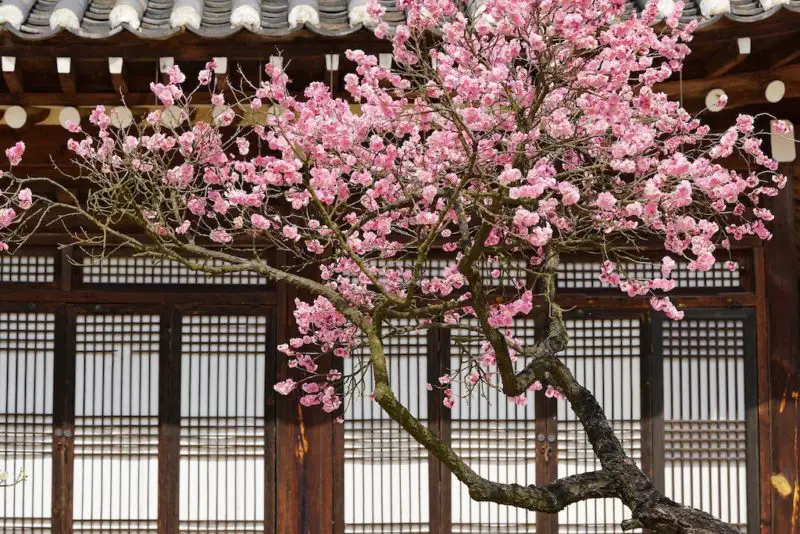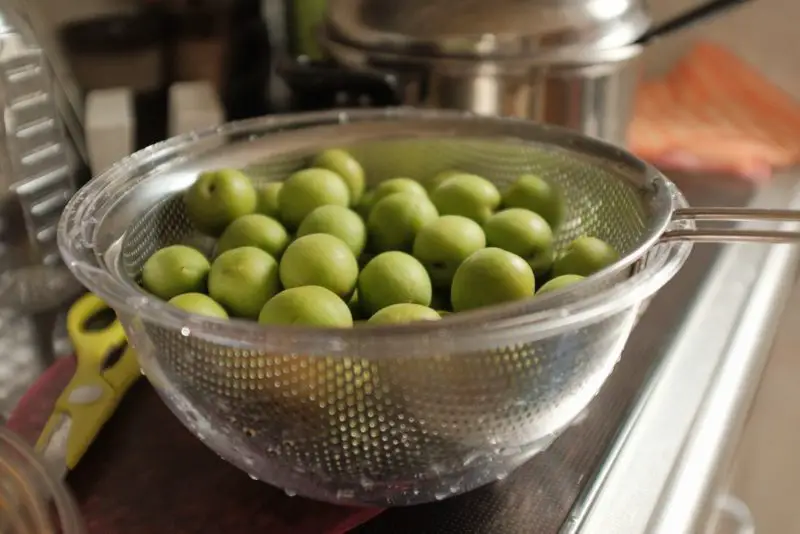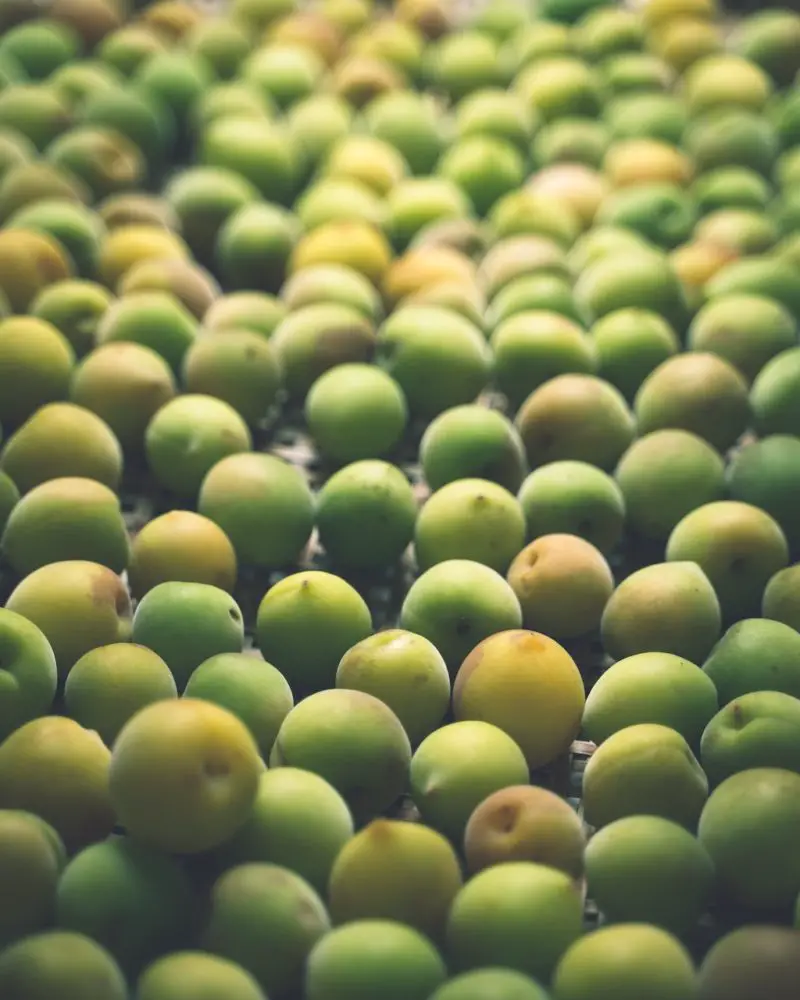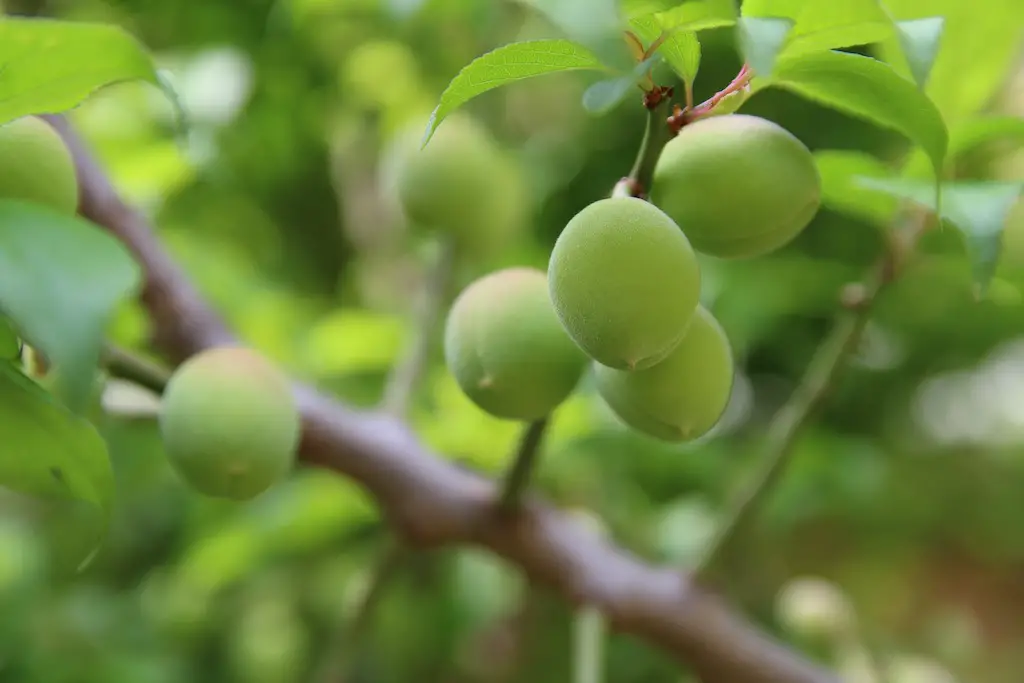This post may contain affiliate links. Please read my disclosure for details at the bottom of this page. As an Amazon Associate, I earn from qualifying purchases on this post about maesil, otherwise known as green plums. We hope you enjoy learning about green plums in Korean cooking! To learn more about further fruits in South Korea, check out our blog post titled ‘Beginners Guide to Korean Fruit.’
The Korean green plum, also known as Chinese plum, Japanese plum, Japanese apricot, and sour green plums, are a type of fruit grown native to East Asia and Southeast Asia. This plant, known as Prunus mume, is a tree species classified in the Armeniaca section of the genus Prunus, making it related to both plum and apricot trees. Interestingly, although we generally refer to this fruit as a plum in English, it is more closely related genetically to an apricot.
In this article, we will discuss green plums in Korean culture as well as their uses in Korean cuisine. Then, we will answer some frequently asked questions about this fruit such as when they are in season and where to buy them!
Note: This tree species should not be confused with cherry blossoms which look similar and grow across most of East Asia. Further, it should also not be confused with another plum species known as Prunus salicina, which produces small red plums across China, Japan, and Korea.
Green Plums in Korean Culture:
The green plum trees are incredibly important to many Easy Asian cultures. Often, you will see depictions of the flowers and branches in traditional paintings, poetry, and writings.
The green plum variety of trees originated around the Yangtze River in the south of China. Then, it was later introduced to the Korean peninsula during the Three Kingdoms Era as well as Japan, Taiwan, and Vietnam.
In Korean culture, plum blossoms, known as ‘maehwa’ (매화), traditionally represent spring. These flowers, along with other flowers such as cherry blossoms and lotus flowers, are used as popular motifs in Korean embroidery, ceramics, painting, and more.

A Plum Tree In Front of a Traditional Korean Building
One famous type of Korean ceramic is known as ‘maebyeong’ (매병). This Korean vessel has a small, curved moth rim with a very short neck. From the neck, it rounds out before tapering down to a thin waist at the bottom. Originally, these vessels derived from the Chinese meiping, which literally translates to ‘plum vase.’ In China and Korea, these vases were first used to gold wine before people later used them to hold branches of plum blossoms.
Finally, beyond the spring reference used in the arts, the people in Korea have utilized the maesil fruit in traditional Korean medicine for centuries. People believe that green plums have a wide variety of health benefits including a boost of energy, good skin, and help with digestion.
Korean Foods Using Maesil (Green Plums):
In South Korea, people commonly use maesil (green plums) to make popular ingredients used in Korean cooking. Below, we list some of the most common ways people use it in Korean cuisine.
First, we will go over ways people use tree blossoms in cooking. Then, I will list some ways people use the actual plum fruit in Korea.

Washed Green Plums–What Should We Cook With Them?
Examples of Foods Using Plum Tree Blossoms:
- Maehwa-Cha (매화차): In English, maehwa-cha translates to ‘plum blossom tea.’ To make this tea, you infuse the plum blossom in hot water.
- Hwajeon (화전): In English, ‘hwajeon’ refers to a type of Korean pancake made using flowers. ‘Maehwa-jeon’ (매화전) is a type of ‘hwajeon’ that uses plum blossoms.
Examples of Foods Using Green Plums:
- Maesil-Cheong (매실청): Maesil-cheong, otherwise known as ‘plum syrup’ or ‘plum extract’ in English, is a syrup made by sugaring ripe plums and leaving them for approximately 100 days. The ratio of sugar to plum is typically 1:1. After they sit, you can use the syrup as a condiment and sugar substitute.
- Maesil-Cha (매실차): In English, maesil-cha translates to ‘green plum tea.’ To make this drink, you mix water with maesil-cheong aka ‘plum syrup.’ Then, you serve this drink either hot or cold.
- Maesil-Ju (매실주): Maesil-ju is a type of plum wine, liquor, or liqueur made by infusing maesil with alcohol such as soju.
- Maesil Jangajji (매실 장아찌): In English, ‘maesil jangajji’ refers to ‘pickled green plums.’ For more pickled Korean food, try making our maneul jangajji (pickled garlic) recipe.

Green Plums Collected.
Green Plums Season:
The Prunus Mume tree starts to flower in mid-to-late winter, starting in January and ending in late February or early March. The flowers can come in varying shades of white, pink, and red but differ from the cherry blossom in shape. On one hand, the petals of a plum blossom are rounded at the tips. On the other hand, cherry blossoms are slightly pointed at the tip with a tiny notch in the center.
The fruit of a plum tree ripens in early summer, between late May and July. This period coincides with the rainy season. Interestingly, in Chinese, the word for this rainy season ‘meiyu’ (梅雨) translates to ‘plum rain.’
Where to Buy Maesil:
During the ripe season, you may find sour green plums in your well-stocked grocery store. That being said, I know that finding fresh green plum fruit can be hit-or-miss depending on your region in the world and grocery store chain.
Instead, I recommend shopping at your local Asian grocery store such as H-Mart. There, you can find fresh green plums available. If you do not live near an Asian market, you can still buy Korean green plum products, like Korean green plum syrup, via online stores such as Amazon.
I Hope You Enjoyed Learning Green Plums (Maesil) in Korean Cuisine!
In the end, I hope you enjoyed learning about maesil. If so, let me know in the comment section below. Also, what do you usually make when cooking with green plums?
If you would like to read more about cooking, you can find further recipes on this blog. I listed some of my favorite Carving A Journey recipes below! For reference, many recipes are influenced by my family’s blended Korean and Southern heritage.
- Baechu (Napa Cabbage) in Korean Cuisine
- What are Perilla Leaves (Kkaennip)?
- Dangmyeon (Sweet Potato Glass Noodles)
- Gochugaru (Korean Pepper Powder)
- Korean Soy Sauce: What Should I Buy?
- Gluten-Free Gochujang Brands; And
- Gluten-free Doenjang Brands
Further Carving A Journey Korean Recipes:
- Greek Momo Recipe (Korean Breakfast Trend)
- Tteokkochi (Korean Rice Cake Skewers)
- Jumeokbap (Handmade Korean Rice Balls); And
- Bibimmyeon (Korean Spicy Cold Noodles)
If you have any questions or comments, you can also email me at [email protected]. And, finally, I would love to hear from you through our social media as well! You can follow me at @carvingajourney on Instagram, Facebook, and Pinterest. I also started a vlog YouTube channel with my husband! Or, if you would like more articles like these, you can subscribe to the blog by joining the mailing list. I hope you enjoyed learning about green plums (maesil)! Thank you so much for stopping by!
Carving A Journey is a participant in the Amazon Services LLC Associates Program, an affiliate advertising program designed to provide a means for sites to earn advertising fees by advertising and linking to Amazon.com. Although we may earn commissions for our endorsement, recommendation, testimonial, and/or link to any products or services from this website, these opinions are my own and I fully support these products.

